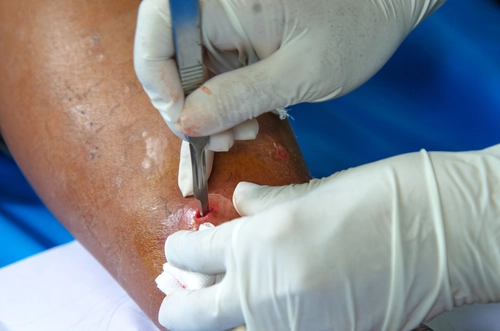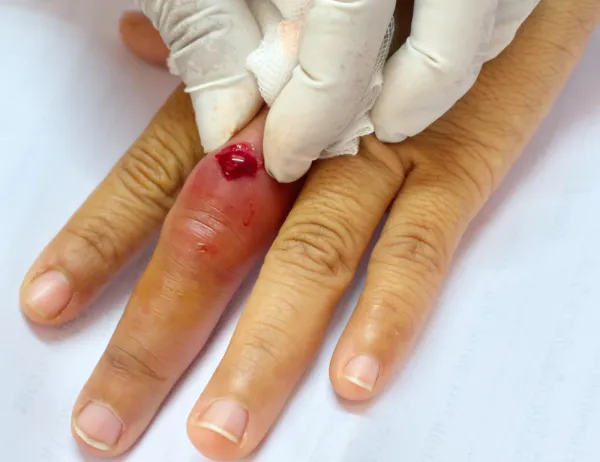Understand The Difference Between Simple And Complicated Pilonidal I&D or Lose $90
Look for instances when you can report an additional E/M.
When your internal medicine specialist performs incision and drainage (I&D) of a pilonidal cyst or sinus, you will have to know that there is a separate code set for this drainage procedure. You should also be aware of identifying the difference between simple and complicated I&D while having knowhow about what to report when your clinician performs the I&D with an excision of the pilonidal cyst.
While you will report most of your internist’s I&D procedures with 10060 (Incision and drainage of abscess [e.g., carbuncle, suppurative hidradenitis, cutaneous or subcutaneous abscess, cyst, furuncle, or paronychia]; simple or single) or 10061 (…complicated or multiple), you’ll need to know that you will need to use another set of codes when you are reporting an I&D of a pilonidal cyst.
If the documentation specifically states “pilonidal cyst,” or provides a detailed location for you to clearly make that conclusion, you can report code 10080 (Incision and drainage of pilonidal cyst; simple) or 10081 (Incision and drainage of pilonidal cyst; complicated).
Reimbursement: The 2015 relative value units (RVUs) for 10080 are 5.08, while 10081 carries 7.61 RVUs. This translates to a Medicare reimbursement of $181.63 for 10080 and $272.09 for 10081 in the non-facility setting. Since the difference in reimbursement is about $90, you will need to be careful in identifying when to report 10081 instead of 10080, or you will lose out on deserved pay.
Differentiate Between Simple and Complicated I&D
To prevent unnecessary loss of deserved pay, you will need to be able to identify when to report a complicated I&D of a pilonidal cyst.
“From a CPT® perspective, the classification of ‘simple’ versus ‘complicated’ is at the physician’s discretion, based on the level of difficulty involved in the incision and drainage procedure,” notes an internal medicine coding expert.
One way to distinguish “simple” from “complicated” in this context is the depth of the cyst and whether or not it has multiple sinus tracts. For instance, you would likely report 10080 when the location of the pilonidal cyst is more superficial or when the lesion is not severely infected or doesn’t have multiple sinus tracts. You may also look at the type of closure that your clinician performed after the procedure. If no closure is done or a simple closure is performed, you will likely report 10080, which corresponds to a “simple” procedure.
On the other hand, if the documentation reads that the location of the cyst was deeper in the subcutaneous layers or if the lesion was severely infected, you will more likely choose 10081 for the I&D, because the procedure will be more extensive and complicated. You may also want to choose 10081 if your clinician mentions the presence of multiple abscesses or sinus tracts in the documentation. Finally, if your clinician performs a layered closure after the procedure and packs the surgical site with wound packing, you will likely report 10081 instead of 10080.
Example: A patient reports to your internist with complaints of pain and tenderness at the apex of his gluteal cleft. He says he began experiencing some pain a few days ago, and the pain has been increasing since then and becomes more pronounced when he tries to sit down. Upon examination, your physician finds a tender, egg-sized mass that has a small opening with a hair at its center. Your clinician then preps the patient, and makes a stab incision to the cyst, which yields 15 ml of pus. He then irrigates the cavity, leaves the wound open, and instructs the patient to schedule a follow-up visit.
What to report: Since your provider drained a superficially located, simple pilonidal cyst and did not perform any wound closure, you will most likely report the procedure with 10080. You also report the ICD-9 code, 685.0 (Pilonidal cyst with abscess) to report the diagnosis of the pilonidal cyst. You report L05.01 (Pilonidal cyst with abscess) if you are using ICD-10 codes to report the diagnosis.
Don’t Report I&D Separately When Performed With Excision
In some instances, your clinician might perform an I&D of a pilonidal cyst and then determine that an I&D will not help in completely eliminating the problem. So, he then performs an excision of the cyst at the same encounter. In such a case, you have three CPT® codes to report the excision of the pilonidal cyst:
CPT® also does not define ‘simple,’ ‘extensive,’ or ‘complicated’ in this context, other than to suggest that it is based on the complexity of the erosion. Thus, the choice of code is again left to the physician’s discretion.
Irrespective of the code that you choose for reporting the excision, you will not report the I&D procedure that your clinician performed prior to the excision with either 10080 or 10081.
CMS guidelines set forth in the Correct Coding Initiative (CCI) state:
If it is necessary to incise and/or drain a lesion as part of another procedure or in order to gain access to an area for another procedure, the incision and/or drainage is not separately reportable if performed at the same patient encounter.
For example, a physician excising pilonidal cysts and/or sinuses (CPT® codes 11770-11772) may incise and drain one or more of the cysts. It is inappropriate to report CPT® codes 10080 or 10081 separately for the incision and drainage of the pilonidal cyst(s).
HCPCS/CPT® codes for incision and drainage should not be reported separately with other procedures such as excision, repair, destruction, removal, etc., when performed at the same anatomic site at the same patient encounter.
However, if your clinician is performing I&D of a pilonidal cyst and, in another anatomic location, he excises another pilonidal cyst or sinus tract, then you can report both the procedures together. But, as CCI edits are in place, you will need to append a modifier to the I&D code, as this is the column 2 code in the edit list. You will need to use modifier 59 (Distinct procedural service) or possibly XS (Separate structure) with 10080 or 10081, which you are reporting for the I&D procedure.
Learn When to Report an Additional E/M Code
When reporting pilonidal cyst I&D or excision codes, you should not report an E/M code with all your claims. Most of the preliminary evaluation that your physician performs prior to the procedure will be included in the work described by the procedural code that you are reporting.
Also, Correct Coding Initiative (CCI) edits are in place that bundle an E/M code with the two I&D codes. However, the modifier indicator for these bundling edits is ‘1,’ which means you can separately report both the E/M code and the I&D code if an appropriate modifier is used to break the edit.
However, you should not report the E/M code every time you are reporting an I&D code. You will only report an E/M code separately if and only if a separate and significant E/M service was performed that was in addition to the preliminary evaluation that your clinician performed. In such a case, you can report both the I&D code and the E/M code together. Since the E/M codes are the column 2 codes in the CCI edit pairs, you will have to append a suitable modifier with the E/M code that you are reporting. The modifier that you will have to use with the E/M code is 25 (Significant, separately identifiable evaluation and management service by the same physician or other qualified health care professional on the same day of the procedure or other service).
Example: Suppose, in the example described above, the patient had hypertension and your internal medicine provider performed further investigations to check whether his present BP levels were alright and if they will pose any adverse problems during the procedure. Since your clinician performed an evaluation that is separate from the preliminary investigation that your clinician typically performs prior to the I&D, you will report this evaluation with an E/M code such as 99213 (Office or other outpatient visit for the evaluation and management of an established patient…) in addition to 10080 and append modifier 25 to 99213 to make clear that the E/M service was significant and separately identifiable from the I&D.




